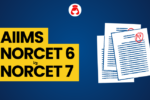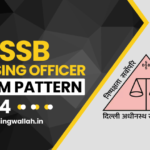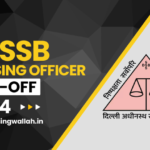DSSSB Nursing Officer Exam Analysis 2024: The Delhi Subordinate Services Selection Board (DSSSB) began the Nursing Officer Exam 2024 on August 12, 2024. The first day of the exam has been completed successfully, with all shifts conducted smoothly. This exam will continue to take place daily in three shifts, starting from August 12 and running until September 6, 2024.
Candidates who have their exams in the upcoming days should carefully review important information, including the DSSSB Nursing Officer Exam Pattern 2024. Understanding the exam analysis, level of difficulty, and ideal number of attempts can be crucial for success. Additionally, going through memory-based questions related to nursing subjects can help in better preparation.
DSSSB Nursing Officer Exam Pattern Overview
The DSSSB Nursing Officer exam follows a consistent pattern, much like the exams from previous years. If you’re preparing for this exam or have recently taken it, it’s important to be familiar with this pattern. Knowing the exam structure helps in better preparation and gives you an idea of what to expect.
Whether you’re revising or planning to take the exam in the future, understanding how the exam is organized is key. This knowledge can boost your confidence and guide your study efforts more effectively.
DSSSB Nursing Officer Exam Structure
The DSSSB Nursing Officer Exam is structured to evaluate candidates in two distinct sections. The first section covers general topics that are not related to nursing. These could include subjects like general awareness, reasoning, and English language skills. The second section is focused on nursing-specific content, where questions are related directly to the nursing profession.

Understanding the structure of these two sections is very important for anyone preparing for the exam. Knowing how the exam is divided helps in planning your study time better. You can focus on both the non-nursing topics and the nursing-related content separately. This approach can improve your overall performance in the exam.
| Section | Subject | Number of Questions | Total Marks | Duration |
|---|---|---|---|---|
| Section A (Non Nursing) | General Awareness | 20 | 20 | |
| General Intelligence & Reasoning Ability | 20 | 20 | ||
| Arithmetic & Numerical Ability | 20 | 20 | ||
| Hindi Language | 20 | 20 | ||
| English Language & Comprehension | 20 | 20 | One Hour | |
| Section B (Nursing) | Nursing Subjects | 100 | 100 | One Hour |
| Total | 200 | 200 | 2 Hours |
DSSSB Nursing Officer Exam Topics
The DSSSB Nursing Officer Exam covers a wide variety of topics across several important sections. These sections include Reasoning, General Knowledge, Mathematics, English, and Hindi. Each section is carefully designed to test different skills and areas of knowledge.
To prepare thoroughly for the exam, it is crucial to understand the topics covered in each section and the depth of content they include. Breaking down each subject and focusing on key areas will help in better preparation. By familiarizing yourself with the exam’s structure, you can approach your studies more effectively and confidently.
| Section | Topics Covered |
|---|---|
| General Intelligence & Reasoning Ability | Logical reasoning and problem-solving questions |
| General Awareness | Questions on current affairs, history, and general awareness |
| Arithmetic & Numerical Ability | Questions on mathematical reasoning and problem-solving |
| English Language & Comprehension | Comprehension and language usage questions |
| Hindi Language | Grammar, synonyms, antonyms, and other language-related topics |
Detailed Analysis of the Non-Nursing Portion
A comprehensive analysis of the non-nursing portion of the DSSSB Nursing Officer Exam provides insights into the structure and content of each section. This portion covers various subjects, including Reasoning, General Knowledge, Mathematics, English, and Hindi. Each subject focuses on different skill areas, requiring candidates to have a clear understanding of the material.
Reasoning tests logical thinking and problem-solving abilities. General Knowledge assesses awareness of current affairs and general topics. Mathematics measures numerical and analytical skills, while English evaluates language proficiency, and Hindi focuses on the candidate’s command of the language.

By understanding the specifics of these sections, candidates can prepare more effectively for the exam. They can tailor their study plans to address their strengths and weaknesses in each area. This targeted preparation will help them perform better and increase their chances of success in the exam.
| Section | Details |
|---|---|
| General Intelligence & Reasoning Ability | Description: The first section in the non-nursing portion. |
| Question Types: Includes logical sequences, pattern recognition, and analytical problems. | |
| Strategy: Allocate sufficient time to solve all reasoning questions effectively. | |
| General Awareness | Description: Follows the reasoning section. |
| Number of Questions: 20 | |
| Content: Recent events, historical facts, and general awareness. | |
| Arithmetic & Numerical Ability | Description: Appears after general knowledge. |
| Number of Questions: 20 | |
| Content: Includes sequences, basic arithmetic operations, and problem-solving. | |
| English Language & Comprehension | Description: Follows the mathematics section. |
| Number of Questions: 20 | |
| Content: Comprehension passages and language usage. | |
| Hindi Language | Description: The final section in the non-nursing portion. |
| Number of Questions: 20 | |
| Content: Grammar, synonyms, antonyms, and other language-related topics. |
Exam Strategy and Recommendations For DSSSB Nursing Officer Exam
For those preparing for the DSSSB Nursing Officer exam, here are some essential tips to help you succeed:
- Sequence of Sections: The non-nursing section always appears in a specific order: Reasoning, General Knowledge, Mathematics, English, and then Hindi. Each of these sections has 20 questions. Knowing this sequence can help you plan your approach better.
- Time Management: Managing your time effectively is crucial. Don’t spend too much time on any one section. This way, you won’t risk running out of time for the sections that follow. It’s important to maintain a steady pace throughout the exam.
- Focus on Non-Nursing Sections: The non-nursing portion can be time-consuming. It’s important to tackle it efficiently so that you have enough time for the nursing-related questions later on.
- Practice Previous Year Papers: A great way to understand the exam pattern is by practicing previous year papers. This will give you an idea of what to expect and help you get comfortable with the types of questions that may appear.
By following these tips, you’ll be better prepared to face the exam confidently and efficiently.
Important Notes for DSSSB Nursing Officer Exam 2024
- No Time Boundaries: When answering the 20 questions in each section, you don’t have to worry about a strict time limit. You are free to take your time on any set of questions. If you feel that one set needs more of your attention, you can focus on it without rushing. This allows you to move at your own pace and ensure that you give each question the time it deserves.
- Submit Sections: Once you have completed all the questions in the non-nursing portion, which consists of 100 questions, you will need to submit this section before moving forward. Submitting it will unlock the nursing portion of the exam. In this next section, you will find another set of 100 questions, which will appear all at once after you complete the non-nursing section. This step-by-step approach ensures that you can focus on one part of the exam at a time, making it easier to manage and understand the content.

Good Attempts for DSSSB Nursing Officer Exam 2024
If you’ve completed your exam and are now evaluating your performance, here’s some guidance to help you understand where you stand:
- Attempting Range: If you answered between 130 to 150 questions and managed to minimize negative marking, your attempt is considered solid. Ideally, you should aim for more than 140 attempts, but be cautious not to overdo it, as this can result in unnecessary negative marking.
- Accuracy Over Quantity: It’s important to prioritize accuracy over the total number of attempts. Strive for around 130-135 correct answers. This balance between accuracy and quantity will put you in a strong position for selection. Remember, it’s not just about how many questions you attempt, but how many you get right that truly matters.
By focusing on these strategies, you can better assess your chances of success and plan your next steps with more confidence.
DSSSB Nursing Officer Exam 2024 Sample Questions and Solutions
To effectively prepare for the DSSSB Nursing Officer exam, it’s essential to understand the types of questions you might encounter. This document offers a collection of sample questions along with their answers to help you get a clear idea of the exam format. By studying these examples, you’ll be able to see the different styles of questions and improve your problem-solving abilities.
Let’s explore these sample questions together. This will give you a better understanding of what to expect and help you build confidence in your preparation. Reviewing these questions will make you more familiar with the exam and ready to tackle it successfully.
| Question | Answer |
|---|---|
| What is the primary indication for Electroconvulsive Therapy (ECT)? | ECT is primarily used for severe depression when other treatments have not been effective. |
| In an ECG, what does a prominent U wave indicate? | A prominent U wave typically indicates hypokalemia (electrolyte imbalance). |
| At what stage of labor does cervical dilation reach 10 centimeters? | Cervical dilation to 10 centimeters occurs in Stage 1 of labor. |
| What is the drug of choice for controlling blood pressure in preeclampsia? | The drug of choice for controlling blood pressure in preeclampsia is usually Magnesium Sulfate (MgSO4). |
| If the blood pressure is controlled with antihypertensives in pregnancy-induced hypertension, which drugs are used? | For controlling blood pressure in pregnancy-induced hypertension, Labetalol is commonly used. Methyldopa is another option, but in cases of preeclampsia or eclampsia, MgSO4 is preferred for controlling blood pressure and preventing seizures. |
| What is the expected weight of a 1-year-old child if the birth weight was 3 kg? | A child’s weight is expected to triple by the age of one year. Therefore, if the birth weight was 3 kg, the expected weight at one year would be 9 kg. |
| What is the meaning of Veracity in ethics? | In ethics, Veracity refers to the principle of telling the truth. It is associated with honesty and integrity. |
| What is the grading for a 6 mm edema? | A 6 mm edema is typically classified as Grade 3 edema. |
| What is the antidote for Warfarin? | The antidote for Warfarin is Vitamin K. |
| What is the procedure used for pancreatic cancer, especially in the head of the pancreas? | The Whipple procedure (or pancreaticoduodenectomy) is used for cancer of the head of the pancreas. |
| What is the extra caloric requirement during pregnancy and lactation? | During pregnancy, the extra caloric requirement is approximately 350 kcal/day, and during lactation, it is around 500 kcal/day. |
| How is vaccine vial monitoring performed for heat-sensitive vaccines like polio? | Vaccine vial monitoring involves checking the color of the vial. If the inside color remains light or if the vial color is still in the acceptable range (light blue or white), the vaccine is usable. If the color changes significantly, the vaccine may not be effective and should not be used. |
DSSSB Nursing Officer Exam 2024: Exam Difficulty Level
The difficulty level of the DSSSB Nursing Officer Exam can vary significantly across different sections. Based on feedback from candidates and the types of questions asked, the exam presents varying challenges. Generally, the quantitative aptitude section is often regarded as the most difficult. On the other hand, many candidates find the English section to be the easiest.
To give you a clearer idea, here’s a detailed overview of the difficulty levels for all sections of the exam.
| Section | Subjects | Question Numbers | Difficulty Level |
|---|---|---|---|
| Section A | General Awareness | 20 | Moderate |
| General Intelligence and Reasoning Ability | 20 | Moderate | |
| Arithmetical and Numerical Ability | 20 | Difficult | |
| Hindi Language and Comprehension | 20 | Moderate | |
| English Language and Comprehension | 20 | Easy | |
| Section B | Subject-specific questions related to the post | 100 | Moderate to Difficult |
To sum up, the DSSSB 2024 Nursing Officer exam has a clear and organized pattern. It is divided into two main sections: one for non-nursing topics and another for nursing-related subjects. Understanding this structure is crucial for effective preparation. It can significantly boost your chances of success if you know what to expect.

For those who have already taken the exam, your experiences and insights can be incredibly valuable. Sharing what you’ve learned can help others as they prepare for their own exams.
We hope this analysis provides you with useful information for your exam preparation. Best of luck to all future candidates! May your hard work and dedication lead you to success.
Stay updated with the latest nursing job alerts and related updates by joining our Telegram and WhatsApp channels. Connect with us today to stay informed about new opportunities and developments in the nursing field.










Your website design is very easy to read.